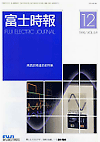FUJI ELECTRIC JOURNAL Vol.69-No.12 (Dec/1996)
 |
Harmonic Suppression and Compensation |
Trend of Harmonic Suppression and Compensation
Kinzo Okazaki
With the rapid development and wide use of power electronics, the amount of harmonic currents generated by the application products is increasing and there is a forecast that power system voltage distortion due to harmonics will exceed the permissible value of the equipment. This paper outline the "guideline to the Control of harmonics" enacted and promulgated in 1994 and briefly introduces the present status and trend of harmonic suppression technologies and countermeasures for Fuji Electric's power electronics products on the market.
Harmonics Caused by Power Converters
Osamu Motoyoshi, Hiroshi Ohsawa
With the wide use of power electrics applications, the overheat of equipment in parallel, such as motors and capacitors, and troubles due to abnormal harmonics in power systems have become actual. To plan appropriate measures against these harmonics, the knowledge of the property of harmonics is necessary. Taking up a thyristor rectifier, a cycloconverter, an AC power controller, and a pulse-width-modulated inverter as typical power converters, this paper outlines harmonics caused by them.
Harmonics in Iron and Steel Plants and Countermeasures
Iwao Shibata, Takao Aritoshi
In iron and steel plants, steelmaking electric-arc furnaces and motor drive application processes with variable-speed drive generate strong harmonics. This paper outline these harmonics and countermeasures against them. In the processes of steel-making electric-arc furnaces, DC arc furnaces generate less harmonics than AC ones. Also described are considerations in preparing specifications for a filter for harmonic suppression and a method of studying harmonic suppression using simulation.
Harmonics in Electric Railways and Countermeasures
Shingo Tsuda, Ryoji Inoue
Electric railways generating strong harmonics have had inductive interference in communications lines and other various troubles due to them, and appropriate measures and analysis technologies have been established. Both in DC and AC systems, many cars as loads move on the rails repeating starts, acceleration, deceleration, and stops; electric railways are highly fluctuating loads to the power source. This paper describes influences of electric railway systems and equipment with these moving, fluctuating loads upon the power source and communications lines, harmonics generated by cars and ground substations, and measures against them.
Harmonics Caused by Large Capacity Rectifier Equipment and Countermeasures
Akira Kamio
The influence of harmonics generated by large capacity rectifier equipment, typically used for electrolysis, upon other electrical equipment may not be ignored. This paper outlines the aspects of harmonics generated by rectifier equipment and influences upon capacitor equipment and generators, and introduces the latest technologies of harmonic reduction and suppression.
Compensators Using Self-turn-off Devices and Their Applications
Katsuya Uto, Mitsutoshi Yamamoto, Kazuo Yoneda
To cope with harmonics and reactive power in power systems, self-excited compensators using self-turn-off devices such as IGBT and GTO are put to practical use. Citing the self-excited flicker compensator (SFC) for suppressing the voltage flicker generated by steelmaking electric-arc furnaces and the active filter for compensating harmonic currents generated by semiconductor power converters as typical examples, this paper describes their principles of operation and merits, and introduces an 13-MVA SFC, FUJIACT series, and new ACT-MiNi series as their applications.
Harmonics Caused by Standard Inverters and Methods for Suppression
Shinobu Kawabata
Standard inverters are classified by input voltage and current ratings, and two guides are applied to them. This paper describes the ranges of application and introduces the enforcement plan for the "guideline to reduce harmonic emission caused by electrical and electronic equipment for household and general use" scheduled from January 1997. With regard to the other one, "guideline to the control of harmonics by consumers of high or special high voltage power supply" the paper gives a method of calculating harmonic currents and introduces the 12-pulse connection method and PWM converter as measures for reducing harmonics.
Harmonics Caused by Uninterruptible Power Systems and Countermeasures
Yasushi Motoki
With the progress of information-oriented society, uninterruptible power systems (UPS's) have come into wide use in order to supply good-quality power to information processing and communication systems. There have been intense demands for UPS's improved in input/output performance and reduced in size, weight, and noise. Because the "guideline to the control of harmonics" were enacted, particularly the suppression of input harmonic currents has become important. This paper describes the transition of UPS harmonic suppression technologies as well as the latest technology and its applications, UPS600 and 650 series.
Harmonic Compensation Using a Synchronous Machine
Takamasa Tenma, Fuyuto Takase, Atsushi Ashizawa
Recently, harmonics have become one of major problems in power systems and a lot of methods of harmonic suppression have been studied. Fuji Electric has developed a new method of harmonic suppression using a synchronous machine. The basic idea is that the 5th and 7th harmonics can be absorbed by the armature winding of the synchronous machine with the field winding excited by the multiphase 6th harmonics. This system can be applied to all kinds of synchronous machines, i.e. generators, motors, and rotary condensers.
Harmonic Simulation Technology
Yosuke Nakanishi, Akira Nakamori, Hiroyuki Iki
With the spread of power electronics applications, harmonics into power systems and heir influences have attracted attention, and now harmonic regulation by the guide is in force. This paper describes the present situation of harmonic analysis technology in Japan and abroad as well as Fuji Electric's analysis examples: (1) analysis using EMTDC provided with superior graphic interface (2) simulation analysis provided with general-purpose table and graph processing functions suitable for document preparation and others on the personal computer.

